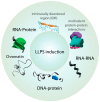Phase Separation as a Driver of Stem Cell Organization and Function during Development
- PMID: 38132713
- PMCID: PMC10743522
- DOI: 10.3390/jdb11040045
Phase Separation as a Driver of Stem Cell Organization and Function during Development
Abstract
A properly organized subcellular composition is essential to cell function. The canonical organizing principle within eukaryotic cells involves membrane-bound organelles; yet, such structures do not fully explain cellular complexity. Furthermore, discrete non-membrane-bound structures have been known for over a century. Liquid-liquid phase separation (LLPS) has emerged as a ubiquitous mode of cellular organization without the need for formal lipid membranes, with an ever-expanding and diverse list of cellular functions that appear to be regulated by this process. In comparison to traditional organelles, LLPS can occur across wider spatial and temporal scales and involves more distinct protein and RNA complexes. In this review, we discuss the impacts of LLPS on the organization of stem cells and their function during development. Specifically, the roles of LLPS in developmental signaling pathways, chromatin organization, and gene expression will be detailed, as well as its impacts on essential processes of asymmetric cell division. We will also discuss how the dynamic and regulated nature of LLPS may afford stem cells an adaptable mode of organization throughout the developmental time to control cell fate. Finally, we will discuss how aberrant LLPS in these processes may contribute to developmental defects and disease.
Keywords: asymmetric cell division; cell fate; cell polarity; chromatin; phase separation; spindle orientation; stem cell.
Conflict of interest statement
The authors declare no conflict of interest.
Figures




References
Publication types
Grants and funding
LinkOut - more resources
Full Text Sources

